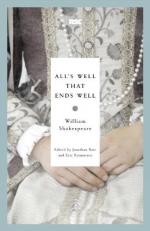|
This section contains 4,561 words (approx. 16 pages at 300 words per page) |

|
SOURCE: "Imagining Consummation: Women's Erotic Language in Comedies of Dekker and Shakespeare," in Look Who 's Laughing: Gender and Comedy, edited by Gail Finney, Gordon and Breach, 1994, pp. 35-52.
In the following essay, Bly examines the role the bedtrick plays in defining Helena as an uncommon Renaissance heroine.
Renaissance comedies of love are inherently both erotic and chaste. They must begin with desire in order to lead to marriage; they must end with love in order to qualify as comedy. The whole can be reduced to an echoing formula: "[they] no sooner met but they looked; no sooner looked but they loved . . . and in these degrees have they made a pair of steps to marriage."' The disturbing potential of turning this simple progression into a play has never been ignored. Sixteenthcentury critics warned of wanton speeches and lascivious delights; twentieth-century critics delineate the crucial erotic investment that...
|
This section contains 4,561 words (approx. 16 pages at 300 words per page) |

|


